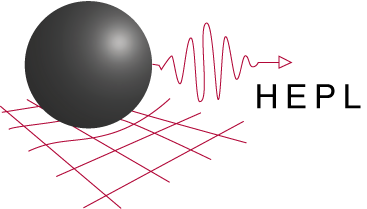News & Events
HEPL-KIPAC Seminar
Wednesday, November 17, 2010
Jennifer Heldmann
Research Scientist
Division of Space Sciences and Astrobiology,
NASA Ames Research Center
Latest Science Results from NASA's LCROSS
(Lunar Crater Observation and Sensing Satellite) Mission
Abstract: The LCROSS (Lunar Crater Observation and Sensing Satellite) mission's objectives were to study a permanently shadowed region near a pole of the Moon. Science goals included investigating the presence or absence of water on the Moon as well as furthering our understanding of other species trapped in these regions. The LCROSS mission launched with the Lunar Reconnaissance Orbiter in June 2009 and used the Atlas V Centaur Earth departure upper stage of the launch vehicle as a ~2300 kg kinetic impactor. The Centaur successfully impacted the Moon within the Cabeus Crater near the lunar south pole. The impact occurred on 9 October 2009 and created an ejecta plume whose properties, including water ice and vapor content, were observed by the shepherding spacecraft (S-S/C) plus Earth- and space-based telescopes. Following a similar trajectory of the Centaur, the S-S/C flew through the Centaur impact plume and then the ~700 kg S-S/C also impacted the Moon.
This paper will focus on results from analysis of the shepherding spacecraft data during its final descent through the impact plume created by the Centaur impact. In particular, discussion will focus on the LCROSS plume that resulted from the lunar impact as well as the detection of water within the LCROSS plume. Interest in the possible presence of water ice on the Moon has both scientific and operational foundations. It is thought that water has been delivered to the Moon over its history from multiple impacts of comets, meteorites and other objects. The water molecules migrate in the Moon's exospheric type atmosphere though ballistic trajectories and can be caught in permanently shadowed polar cold traps that are cold enough to hold the water for billions of years. The LCROSS mission is providing key information on the enigmatic permanently shadowed regions of our Moon.
Bio: Dr. Jennifer Heldmann is a Research Scientist in the Division of Space Sciences and Astrobiology at NASA Ames Research Center located at Moffett Field, California. Heldmann received a B.S. in Astrogeophysics from Colgate University, a MasterÕs in Space Studies with a minor in Geology from the University of North Dakota, and a Ph.D. in Planetary Science from the University of Colorado at Boulder.
Heldmann has written numerous scientific papers and book chapters and is the recipient of numerous NASA Achievement Awards including a NASA Headquarters Special Act Award, NASA Ames Honor Award, and multiple NASA Group Achievement Awards. She was the Science Organizing Chair for the recent 2010 NASA Lunar Science Forum. She has been featured in multiple public venues discussing Moon and Mars research (NPR, History Channel, National Geographic, etc). She is committed to education and public outreach and is keen to inspire the next generation of scientists and explorers by sharing the excitement of Solar System exploration with students, teachers, and the general public whenever possible.
Time: 4:00pm – 5:30pm
Location: Physics and Astrophysics Conference Room 102/103
Light refreshments available 4:00pm; Presentation begiins 4:15pm.
Open to All


